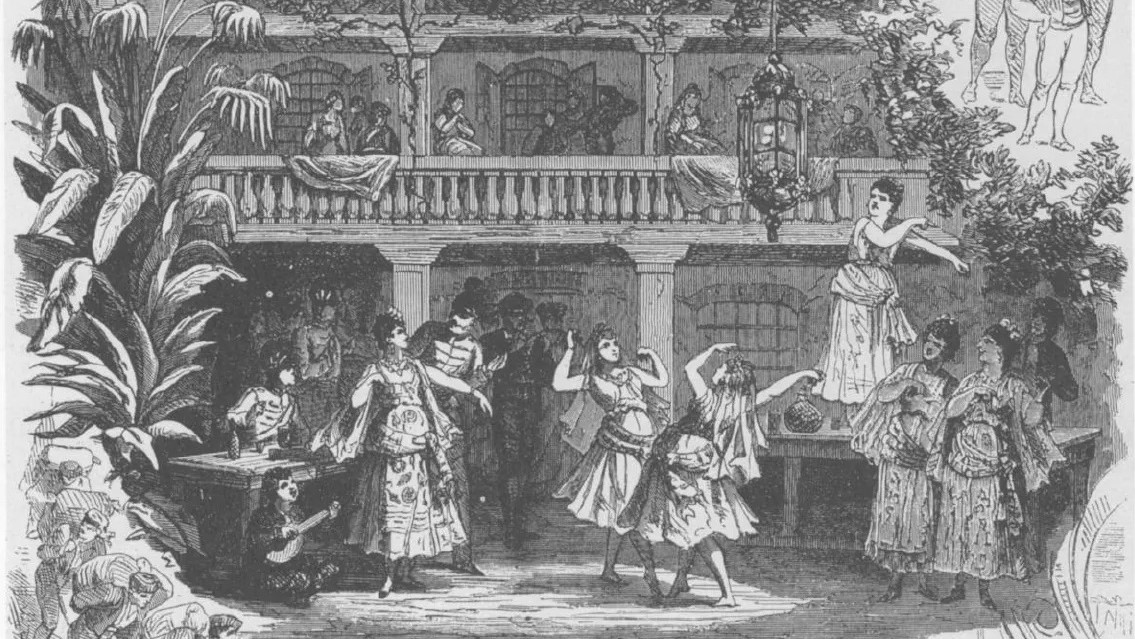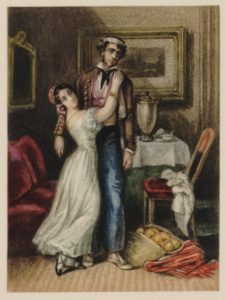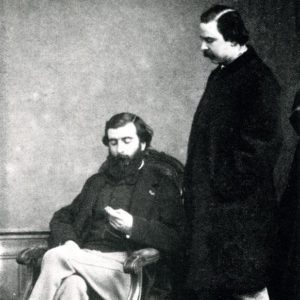Roma Stereotypes in Carmen

Image: carmenabroad.org
By: Bethany Wood
As Jeremy Johnson, dramaturg for Houston Grand Opera explains, “Carmen has always been called a ‘g*psy,’ an exonym for the Romani people that has long been used as a pejorative slur, often to justify oppressive public policy.” The exonym, a name not used by the people group it is used to identify, is a European word stemming from the misrecognition of Roma people as originating from Egypt and is now widely understood as a demeaning term.
Historical Understanding of the Romani People

Image: National Library of France
Productions of Bizet’s opera have historically portrayed Carmen as an exoticized stereotype of Romani women. This characterization originated in Bizet’s source material for the opera, Prosper Mérimée’s novella Carmen (1845), originally published as a serial in the culture journal Revue des Deux Mondes, (Review of Two Worlds). The journal primarily published non-fiction, including Mérimée’s own series of “Letters from Spain,” an account of his travels. In this context, Mérimée’s Carmen mimicked contemporary scientific studies of Roma, including George Borrow’s “The Zincali: An Account of the G*psies of Spain” (1841) and Friderich Pott’s “Die Zigeuner in Europa und Aisen” (vol 1. 1844), both works familiar to Mérimée when he wrote Carmen.
Mérimée found inspiration for Carmen in a story he had heard about a young woman murdered by a jealous man. Although the tale did not originally involve Roma, Mérimée capitalized on the growing market for stories involving Roma by making the heroine of his tale a woman from this ethnic group, a culture understood as exotic and, thus, exciting to white European readers.
Roma Stereotypes in the Source Material
Mérimée’s story is told through the voice of a French narrator who travels to Spain in 1830 on an archeological mission. The traveler encounters Don José, who befriends him and relays the tale of his tempestuous relationship with Carmen, a Roma woman, whom the narrator later meets. The story embraces numerous negative stereotypes of Romani women, describing Carmen as “a strange and savage beauty” who dresses immodestly, smokes, enjoys violence, and engages in fortunetelling and the occult. Don José portrays Carmen as a dangerous and irresistible seductress who entices numerous men in the novel to their doom, including himself.
Carmen values freedom above all, to the point that she would rather die than tie herself to a life of permanence with Don José. Her extreme pursuit of freedom idealizes the myth of rootlessness as an intrinsic Roma characteristic rather than one imposed through repeated, enforced dispossession enacted throughout centuries of oppression. In addition to nomadic life, Mérimée’s tale romanticizes the violence, poverty, and exploitation that characterize Carmen’s life in the novel. Presented in the context of a non-fiction journal and the (fictitious) perspective of a scientific explorer, Mérimée’s Carmen blurred the line between fiction and truth, presenting Don José and his encounters with Carmen as authentic accounts of Roma life.
Characterizations of Roma in Bizet’s Carmen

Photo: Art Lyrique
When adapting Carmen, Bizet and his librettists, Ludovic Halévy and Henri Meilhac capitalized on Mérimée’s vivid characterization of Carmen, incorporating much of the exoticism from the novella. As with the novella, Bizet’s Carmen and her fellow Romani are a simulacra of Spanish Roma, made up of melodies, costumes, mannerisms, and ideologies Bizet, Halévy, and Meilhac understood as representative of Romani culture but, in reality, were based on an amalgam of information from Russian (Pushkin), French (Mérimée), and English (Borrow) authors, whose works the adapters employed to present Carmen as an authentic representation of Romani life and society.
Discover how Carmen has continued to be adapted into our modern pop culture.>>
Opera scholar Judy Tsou describes this process in relation to the opera’s music as well. Tsou details Bizet’s efforts to exoticize Carmen in one of the opera’s most famous songs, the “Habernara.” According to Tsou:
“The original tune (“El Arreglito”) is by Basque composer Sebastian Yradier (1809–1865) which used the popular habanera rhythm from Havana. Thus, Bizet’s sound is not ethnically authentic; it is Spanish Basque with a Cuban touch. This song was likely to have been performed in cabarets and other popular music venues, a ‘foreign’ genre to operas. In addition to the Basque song, Bizet included cabaret and other popular music, modal sounds of the Middle East, and Spanish flamenco to paint the exotic Carmen.”
Although Carmen, initially failed to gain critical acclaim, the ultimate popularity of Bizet’s opera has established Carmen as one of the most well-known protagonists in opera, drawing attention to stereotypes and depictions of Roma in popular culture.
—
What learning have you done about the Roma people? What questions do you have questions about their culture?
—
Bibliography
Charnon-Deutsch. The Spanish Gypsy: The History of a European Obsession. University Park: The Pennsylvania State University Press, 2004.
Cortés, Ismael and Cayetano Fernández. “Long Sad History of Roma in Spain.” Le Monde diplomatique, May, 2015. https://mondediplo.com/2015/05/13Roma.
Guy, Will. Ed. Between Past and Future: The Roma of Central and Eastern Europe. Hatfield, Hertfordshire: University of Hertfordshire Press, 2001.
Johnson, Jeremy. Houston Grand Opera. “Considering Carmen: Great Art, Harmful Stereotypes, and a 21st-century Dilemma.” Accessed April 26, 2022. https://www.houstongrandopera.org/blog/posts/2021/october/considering-carmen/.
Merimee, Prosper. Carmen. New York: The Happy Hour Library, Inc. n.d.
Northup, George T. “The Influence of George Borrow on Prosper Mérimée.” Modern Philology 13 no. 3 (July 1915): 143-56. JSTOR.
Ortega, Araceli Canadas. RomArchive. “Anti-Gypsy Legislation in Spain from the Catholic Kings to the Great Raid.” Accessed April 26, 2022. https://www.romarchive.eu/en/flamenco/antigypsy-legislation-spain/.
Tsou, Judy. Seattle Opera. “Cultural Contrast in Bizet’s Carmen at the Opéra Comique.” Accessed April 21, 2022. https://www.seattleoperablog.com/2019/04/cultural-contrast-in-bizets-carmen-at.html.


